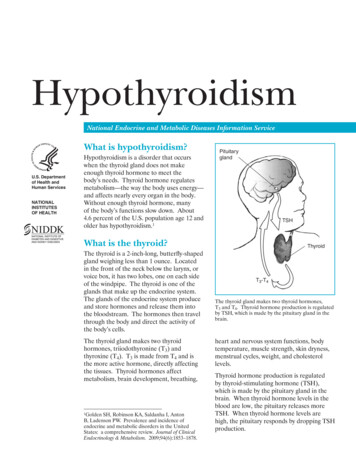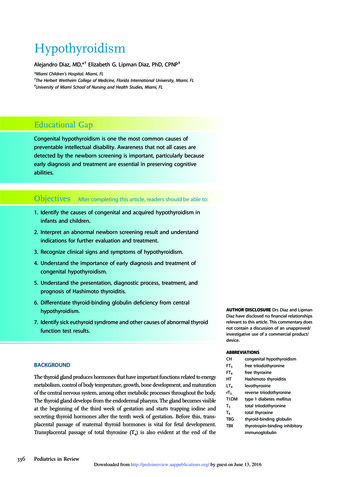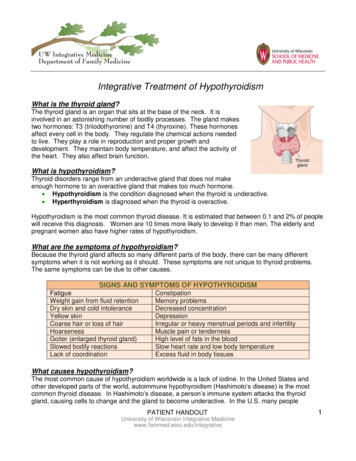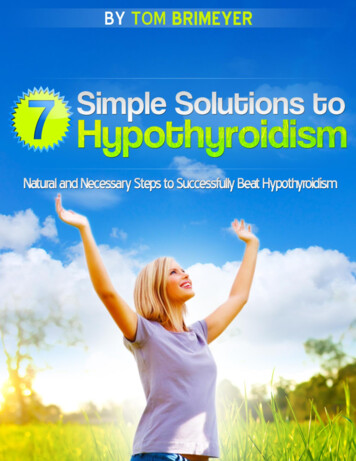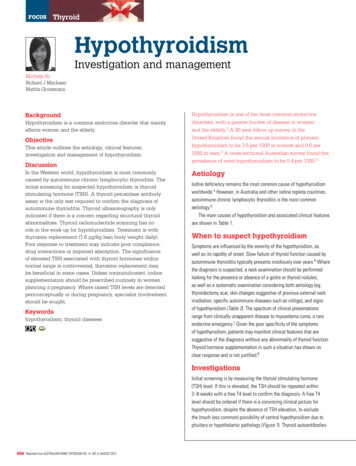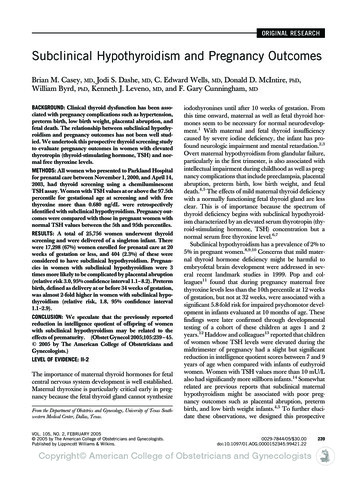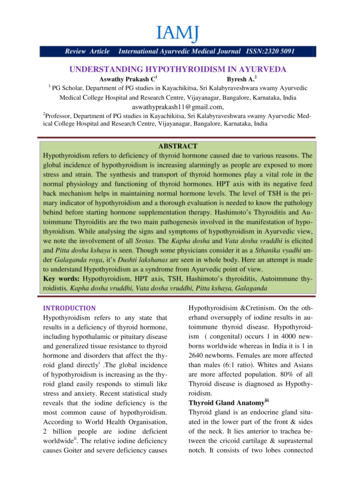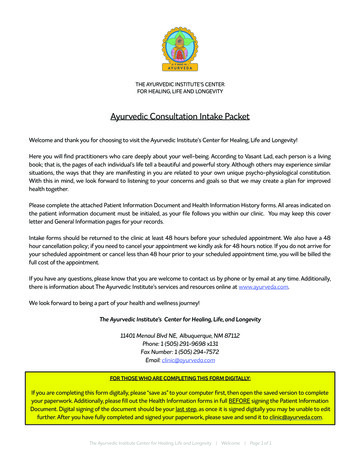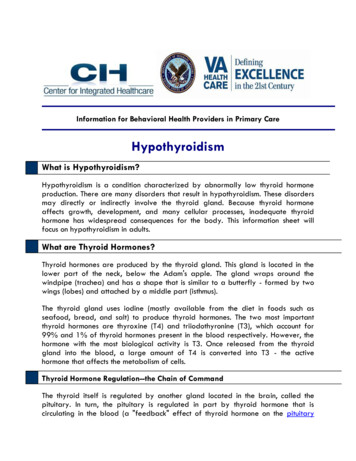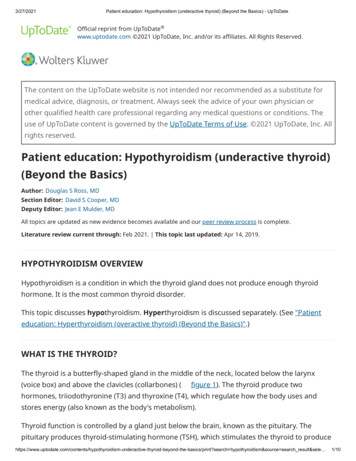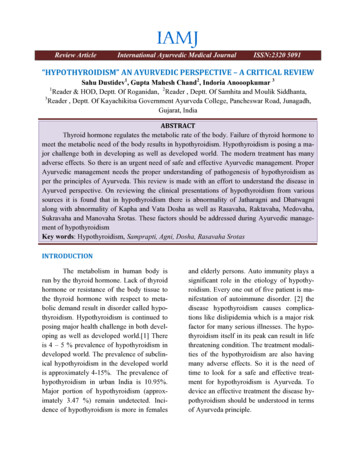
Transcription
Review ArticleInternational Ayurvedic Medical JournalISSN:2320 5091“HYPOTHYROIDISM” AN AYURVEDIC PERSPECTIVE – A CRITICAL REVIEWSahu Dustidev1, Gupta Mahesh Chand2, Indoria Anooopkumarkumar 32Reader & HOD, Deptt. Of Roganidan,Roganidan Reader , Deptt. Of Samhita and Moulik Siddhanta,Siddhant3Reader , Deptt. Of Kayachikitsa Government Ayurveda College, Pancheswar Road, Junagadh,JunagadhGujarat, India1ABSTRACTThyroid hormone regulates the metabolic rate of the body. Failure of thyroid hormone tomeet the metabolic need of the body results in hypothyroidism. Hypothyroidism is posing a mamjor challenge both in developing as well as developed world. The modern treatment has manyadverse effects. So there is an urgent need of safe and effective Ayurvedic management.nagement. ProperAyurvedic management needs the proper understanding of pathogenesis of hypothyroidism asper the principles of Ayurveda.a. This review is made with an effort to understand the disease inAyurved perspective. On reviewing the clinical presentationspresentations of hypothyroidism from varioussources it is found that in hypothyroidism there is abnormality of Jatharagni and Dhatwagnialong with abnormality of Kapha and Vata Dosha as well as Rasavaha, Raktavaha, Medovaha,Sukravaha and Manovaha Srotas. These factors should be addressed during Ayurvedic management of hypothyroidismKey words: Hypothyroidism, Samprapti, Agni, Dosha, Rasavaha SrotasINTRODUCTIONThe metabolism in human body isrun by the thyroid hormone.rmone. Lack of thyroidhormone or resistance of the body tissue tothe thyroid hormone with respect to metametbolic demand result in disorder called hypohypthyroidism. Hypothyroidism is continued toposing major health challenge in both develdeveoping as well as developed world.[1]world.Thereis 4 – 5 % prevalence of hypothyroidism indeveloped world. Thehe prevalence of subclinsubcliical hypothyroidism in the developed worldis approximately 4-15%. The prevalence ofhypothyroidism in urban India is 10.95%.Major portion of hypothyroidism (approx(approimately 3.47 %) remain undetected. InciIncdence of hypothyroidism is more in femalesand elderly persons. Auto immunity plays asignificant role in the etiology of hypothyhypothroidism. Every one out of five patient is mamnifestation of autoimmune disorder. [2] thedisease hypothyroidism causes complicacomplictions like dislipidemia which is a major riskfactor for many serious illnesses.illnesses The hypothyroidism itself in its peak can result in lifethreatening condition. The treatment modalities of the hypothyroidism are also havingmany adverse effects. So it is thet need oftime to look for a safe and effective treattreament for hypothyroidism is Ayurveda. Todevice an effective treatment the disease hypothyroidism should be understood in termsof Ayurveda principle.
Sahu Dustidev Et&All:“Hypothyroidism” An Ayurvedic Perspective – A Critical ReviewThis review is carried out with anaim to understand the disease hypothyroidism in principle of Ayurveda. The presentation of hypothyroidism is reviewed criticallyby searching pathogenesis and symptomsfrom various research databases. The symptoms of hypothyroidism are studied in termof imbalance of Dosha, Srotas etc and aneffort is made to obtain a standard possibleSamprapti of hypothyroidism.Materials and MethodsThis study is carried out by literaturesearch and critical review of the obtainedfacts. The pathogenesis of hypothyroidism isobtained by searching various medical research databases like pubmed, Google scholar, Embase and other national research databases. The terms entered for search are“hypothyroidism”, “hypothyroidism clinicalpresentation”, “hypothyroidism pathogenesis”, and “thyroid physiology”, etc. Manualsearch was made by going through the reference list of retrieved articles to identify relevant additional study. The study of variousAyurvedic texts were made critically and aneffort is made to understand the pathogenesis of hypothyroidism.Observation and DiscussionPhysiological effect of Thyroid HormoneThere are two major thyroid hormones T3 and T4 which effects on all bodysystems and at all stages of life. These helpin proper development during the fetal period and the first few months after birth.Thyroid hormones also promote growth asthey enhance amino acid uptake by tissuesand enzymatic systems involved in proteinsynthesis thus promoting bone growth. Carbohydrate metabolism is also regulated bythe thyroid hormone as it stimulates glucoseuptake, glycogenolysis, gluconeogenesis.These actions may be compared to functions149www.iamj.inof Rasavaha Srotas as it supplies nutritionand energy to all body tissue. They help infat metabolism by mobilizing lipids fromadipose stores and accelerate oxidation oflipids to produce energy (occurs within mitochondria), as well as increasing the sizeand number of mitochondria. Lipid metabolism can compared to functions of MedovahaSrotas. Thyroid hormones also increase basal metabolic rate (BMR) in all tissues exceptbrain, spleen and gonads. This results in increased heat production, increased oxygenconsumption. This increased metabolic ratealso results in increased utilization of energysubstrates causing weight loss. These actionscan be compared to the functions of Agni inthe body[3]. The adrenergic receptors in theblood vessels are also increased by the action of thyroid hormone leading to regulation of blood pressure. Thyroid hormoneplay a vital role in tissue growth particularlyin skeletal, nervous system and reproductivesystem Cardiovascular action of thyroidhormones are to increase cardiac output,heart rate and contractility. They affect therespiratory system indirectly through increased BMR causing increased demand foroxygen and increased excretion of carbondioxide. These physiological actions if lookat Ayurvedic perspective are the action ofPitta and Vata Dosha. The Srotas affected bythyroid hormone are mainly Rasavaha Srotas, Mamsavaha Srotas, Medovaha Srotas,Asthivaha Srotas, Sukravaha Srotas.Etiology of HypothyroidismHypothyroidism is caused by inadequate function of the thyroid gland itselfcalled primary hypothyroidism or by notgetting enough stimulation by thyroidstimulating hormones called secondary hypothyroidism. Primary hypothyroidism iscaused by iodine deficiency, autoimmuneIAMJ: Volume 3; Issue 1; January - 2015
Sahu Dustidev Et&All:“Hypothyroidism” An Ayurvedic Perspective – A Critical Reviewdisease, radiation therapy, drugs or thyroidsurgery.[4] So far Ayurvedic Nidan is concerned the etiological factors related to Kapha-Vata Prakopaka, Agnimandya Janakaand Rasapradoshaka Nidan will may be responsible for the genesis of hypothyroidism.Clinical Presentation of HypothyroidismHypothyroidism results from failureof thyroid gland to produce enough thyroidhormones to meet the metabolism of body orfrom resistance of peripheral tissue to thyroid hormone. Hypothyroidism results in slowSymptom/Sign[5] [6] [7] [8]fatigue, loss of energy,Lethargy, SleepinessWeight gainDecreased appetiteCold intolerance, Hypothermia (only insevere hypothyroid states)Dry skinHair loss, Coarse, brittle, straw-like hair,Loss of scalp hair, axillary hair, pubichair, or a combinationMuscle pain, joint pain, weakness in theextremitiesDull facial expression, Depression, Emotional liability, mental impairment, Forgetfulness, impaired memory, inability toconcentrateHyporeflexia with delayed relaxation,ataxia, or bothBlurred vision, Decreased hearingConstipationMenstrual disturbances, impaired fertilityDecreased perspirationParesthesias, nerve entrapment syndromesFullness in the throat, hoarsenessJaundice, Pallor150www.iamj.ining of metabolic process and energy expenditure. Hypothyroidism usually results in amultitude of clinical signs and symptoms.The degree of thyroid dysfunction and thetime course of development of hypothyroidism determine the severity of manifestations.The symptoms of hypothyroid are very nonspecific. However common presentations ofhypothyroidism along with its Ayurvedicperspective are tabulated below;Symptoms and Signs of HypothyroidismDosha Involved[9]VataKaphaKaphaKaphaVata, KaphaSrotas Involved[10] [11]VataVataRasavahaAsthivahaVataAsthivaha, aha, Raktavaha,ManovahaIndriyaPurishavahaArtavavaha, SukravahaMedovahaRasa, Meda, MajjaKaphaPittaPranavahaRasavaha RaktavahaIAMJ: Volume 3; Issue 1; January - 2015RasavahaRasavahaRasavahaAnnavaha, RasavahaRasavaha
Sahu Dustidev Et&All:“Hypothyroidism” An Ayurvedic Perspective – A Critical ReviewCoarse facial features, Periorbital puffiness, MacroglossiaGoiter (simple or nodular)Bradycardia, Decreased systolic bloodpressure and increased diastolic bloodpressurePericardial effusion, Abdominal distention, ascites (uncommon), Nonpittingedema (myxedema), Pitting edema of lower extremitiesFrom the above table it is clear thatin hypothyroidism there is abnormality ofJatharagni and Dhatwagni along with abnormality of Kapha and Vata Dosha as wellas Rasavaha, Raktavaha, Medovaha, Sukravaha and Manovaha Srotas. Cardiac functionand cardiovascular hemodynamics is readilyregulated by the thyroid hormone T3. Hypothyroidism causes decreased cardiac contractility and cardiac output as well as increased peripheral resistance.[12]. Thesefindings may indicate morbidity of RasavahaSrotas in hypothyroidism. Hypothyroidismpatients show increased carotid artery intima-media thickness due to artherosclerosis,and elevated total cholesterol, elevated highdensity lipoprotein which improve on hormone replacement therapy.[13] In cases ofovert hypothyroidism the serum triglycerides remain high and the high density lipoprotein level remain low.[14] These factssupport the abnormality of Medovaha Srotasin the pathogenesis of hypothyroidism.Study show that hypothyroidism shows milddecrease in seminal volume, mild decreasein progressive forward motility of sperm andmild decrease in cumulative percentage ofmobile forms of sperm.[15] Hypothyroidphase of hypothyroidism displays hypergonadotropism, low serum testosterone and151www.iamj.inKaphaRasavahaKaphaRasavaha, Mamsavaha,MedovahaRasavaha, RaktavahaVataKaphasubnormal testosterone response to humanchorionic gonadotripism and these abnormalities revert back on thyroxin substitution.[16] These facts support involvement ofSukravaha Srotas in hypothyroidism. Elderly patient with hypothyroidism have lowMini-Mental State Examination score thaneuthyroid counterpart.[17] Hypothyroidismis known to induce various neurological andmental dysfunctions[18] which supportsManovaha Srotas abnormality in this disorder.Principle of treatmentThe line of treatment with specifictarget to Rasavaha, Mamsavaha, Medovaha,Manovaha Srotas as well as Vata Doshashould be administered in Hypothyroidism.The few Ayurvedic drugs commonly used inpractice are Tinospora cordifolia, Aswagandha, Silajit, Guggula, Boerhavia diffusaetc. On an experimental study it is shownthat Ashwagandha root extract stimulatesthyroidal activity and also enhances the antiperoxidation of hepatic tissue in rats. [19]tinospora cordifolia is a well known immunomodulatory drug[20] which may beproved beneficial in autoimmune hypothyroidism. A case study by Kaur Jagmeet et allReported that administration of KanchanaraGuggulu and Varunadi Kashaya significant-IAMJ: Volume 3; Issue 1; January - 2015
Sahu Dustidev Et&All:“Hypothyroidism” An Ayurvedic Perspective – A Critical Reviewly reduce TSH level during treatment without any adverse effect.[21] Fresh ginger(Zingiber officinale) extracts significantlyreduces total cholesterol, low density lipoprotein in the serum of propylthiouracilinduced hypothyroidic rat.[22]CONCLUSIONAlthough the disease hypothyroidismis not described in classical Ayurvedic texts.Based on its clinical presentation its Samprapti (pathogenesis) can be understood asfollows;Nidana-Santarpanottha,DoshaKapha,Vata, Dushya-Rasa, Meda, Mamsa,Asthi, Majja, Sukra, Samuththana-Amasaya,Adhisthana-Sarva Sareera, SrotodushtiSanga, Rogamarga: Abhyantara(Kostha),Srotodusti: Sanga , Agni Mandya: Ama JatharAgni Mandya Janita, Ama Rasa-RaktaDhatvagni Jaita. During the treatment of hypothyroidism these pathogenetic factors hasto be targeted with special attention tostrength of body, mind, and Dosha.REFERENCES1. Unnikrishnan AG, Menon UV. Thyroiddisorders in India: An epidemiologicalperspective. Indian J Endocrinol Metab. 2011 Jul;15(Suppl2):S78–81.2. Unnikrishnan AG, Kalra S, Sahay RK,Bantwal G, John M, Tewari N. Prevalence of hypothyroidism in adults: Anepidemiological study in eight cities ofIndia. Indian J Endocrinol Metab.2013;17(4):647–52.3. Charaka Samhita of Agnivesha elaborated by Charaka and Drudhabala withthe Ayurveda Dipika commentry byChakrapani dutta, Sutrasthana, Chapter-12, Verse No-11, Page-80 Editedby: Vaidya Jadavji Trikamji AcharyaPublished by Choukhambha SurbharatiPrakashan, Varanasi Edition Reprint2005.152www.iamj.in4.Díez JJ. Hypothyroidism in PatientsOlder Than 55 Years An Analysis ofthe Etiology and Assessment of the Effectiveness of Therapy. J Gerontol ABiol Sci Med Sci. 2002 May1;57(5):M315–20.5. Orlander PR, Griffing GT, VargheseJM, Freeman LM. HypothyroidismClinical Presentation [Internet]. Medscape, Drugs & Disease. e/122393-clinical6. Garber JR, Cobin RH, Gharib H, Hennessey JV, Klein I, Mechanick JI, et al.Clinical practice guidelines for hypothyroidism in adults: cosponsored bythe American Association of ClinicalEndocrinologists and the AmericanThyroid Association. Endocr Pract OffJ Am Coll Endocrinol Am Assoc ClinEndocrinol. 2012 Dec;18(6):988–1028.7. Saito I, Ito K, Saruta T. Hypothyroidism as a cause of hypertension. Hypertension. 1983 Jan 1;5(1):112–5.8. Duyff RF, Bosch JV den, Laman DM,Loon B-JP van, Linssen WHJP. Neuromuscular findings in thyroid dysfunction: a prospective clinical andelectrodiagnostic study. J Neurol NeurosurgPsychiatry.2000Jun1;68(6):750–5.9. Charaka Samhita of Agnivesha elaborated by Charaka and Drudhabala withthe Ayurveda Dipika commentry byChakrapani dutta, Sutrasthana, Chapter-20, Verse No-11,12,17,18, Page113-115 Edited by: Vaidya Jadavji Trikamji Acharya Published by Choukhambha Surbharati Prakashan, Varanasi Edition Reprint 2005, Sloka No:10. Charaka Samhita of Agnivesha elaborated by Charaka and Drudhabala withthe Ayurveda Dipika commentry byChakrapani dutta, Sutrasthana, Chapter-28, Verse No-9-22, Page-179Edited by: Vaidya Jadavji TrikamjiIAMJ: Volume 3; Issue 1; January - 2015
Sahu Dustidev Et&All:“Hypothyroidism” An Ayurvedic Perspective – A Critical Review11.12.13.14.15.16.17.Acharya Published by ChoukhambhaSurbharati Prakashan, Varanasi EditionReprint 2005.Charaka Samhita of Agnivesha elaborated by Charaka and Drudhabala withthe Ayurveda Dipika commentry byChakrapani dutta, Sutrasthana, Chapter-24, Verse No-25-27, Page-125Edited by: Vaidya Jadavji TrikamjiAcharya Published by ChoukhambhaSurbharati Prakashan, Varanasi EditionReprint 2005.S D, I K. Thyroid hormone and thecardiovascular system. Minerva Endocrinol. 2004 Sep;29(3):139–50.Monzani F, Caraccio N, Kozàkowà M,Dardano A, Vittone F, Virdis A, et al.Effect of Levothyroxine Replacementon Lipid Profile and Intima-MediaThickness in Subclinical Hypothyroidism: A Double-Blind, Placebo- Controlled Study. J Clin Endocrinol Metab.2004 May;89(5):2099–106.Abdel-Gayoum AA. Dyslipidemia andserum mineral profiles in patients withthyroid disorders. Saudi Med J. 2014Dec;35(12):1469–76.Hernández JJC, García JMM, GarcíaDiez LC. Primary Hypothyroidism andHuman Spermatogenesis. Syst BiolReprod Med. 1990 Jan 1;25(1):21–7.Kumar J, Khurana ML, Ammini AC,Karmarkar MG, Ahuja MMS. Reproductive Endocrine Functions in Menwith Primary Hypothyroidism: Effectof Thyroxine Replacement. Horm Res.1990;34(5-6):215–8.Ceresini G, Lauretani F, Maggio M,Ceda GP, Morganti S, Usberti E, et al.Thyroid Function Abnormalities andCognitive Impairment in Elderly153www.iamj.in18.19.20.21.22.People: Results of the Invecchiare inChianti Study: THYROID FUNCTION, AGING, AND COGNITION. JAm Geriatr Soc. 2009 Jan;57(1):89–93.Monzanil F, Guerra PD, Caracciol N,Pruneti CA, Puccil E, Luisit M, et al.Subclinical hypothyroidism: neurobehavioral features and beneficial effectof l-thyroxine treatment. Clin Investig.1993 May 1;71(5):367–71.Panda S, Kar A. Changes in ThyroidHormone Concentrations after Administration of Ashwagandha Root Extractto Adult Male Mice. J Pharm Pharmacol. 1998;50(9):1065–8.Upadhyay AK, Kumar K, Kumar A,Mishra HS. Tinospora cordifolia(Willd.) Hook. f. and Thoms. (Guduchi) – validation of the Ayurvedicpharmacology through experimentaland clinical studies. Int J AyurvedaRes. 2010;1(2):112–21.Kaur J, Chouhan M. Kanchanar Guggulu and Varunadi Kashaya in Hypothyroidism - A Case Study. Int J AyurPharma Res. 2014;2(2):58–60.Al-Noory AS, Amreen A-N, HymoorS. Antihyperlipidemic effects of gingerextracts in alloxan-induced diabetesand propylthiouracil-induced hypothyroidism in (rats). Pharmacogn Res.2013;5(3):157–61.CORRESPONDING AUTHORDr. Sahu DustidevReader & HOD, Deptt. Of RoganidanGovernment Ayurveda CollegePancheswar Road, Junagadh, Gujarat, IndiaEmail: drdrustidev@gmail.comIAMJ: Volume 3; Issue 1; January - 2015
meet the metabolic need of the body results in hypothyroidism. Hypothyroidism is posing a m jor challenge both in developing as well as developed world. The modern treatment has many adverse effects. So there is an urgent need of safe and effective Ayurvedic management needs the proper understanding of pathogenesis of hypothyroidism as
